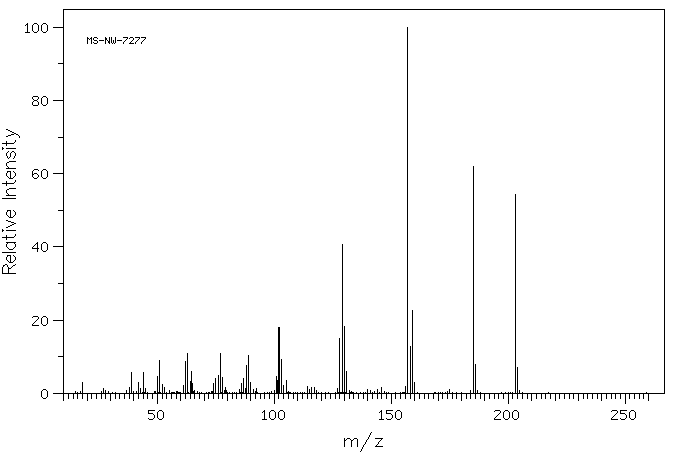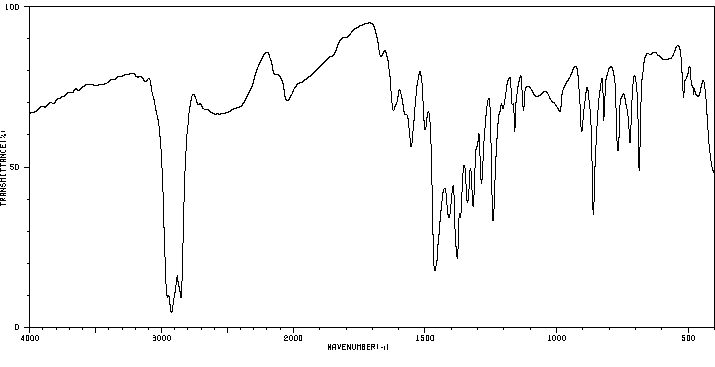2-甲基-3-羟基喹啉-4-羧酸 | 117-57-7
中文名称
2-甲基-3-羟基喹啉-4-羧酸
中文别名
3-羟基喹哪啶-4-甲酸;2-甲基-3-羟基喹啉-4-甲酸;3-羟基-2-甲基-4-喹啉羧酸;3-羟基喹哪啶-4-羧酸
英文名称
3-hydroxy-2-methyl-4-quinolinecarboxylic acid
英文别名
3-hydroxy-2-methylquinoline-4-carboxylic acid;3-hydroxy-quinaldine-4-carboxylic acid
CAS
117-57-7
化学式
C11H9NO3
mdl
MFCD00044850
分子量
203.197
InChiKey
RVGATDHHYVSTQG-UHFFFAOYSA-N
BEILSTEIN
——
EINECS
——
-
物化性质
-
计算性质
-
ADMET
-
安全信息
-
SDS
-
制备方法与用途
-
上下游信息
-
文献信息
-
表征谱图
-
同类化合物
-
相关功能分类
-
相关结构分类
物化性质
-
熔点:235 °C (dec.) (lit.)
-
沸点:341.49°C (rough estimate)
-
密度:1.2621 (rough estimate)
-
闪点:252 °C
-
溶解度:水中的溶解度为0.04 克/升 (20°C)
-
LogP:2.9
-
稳定性/保质期:
常温常压下稳定,避免与不相容材料及强氧化剂接触。
计算性质
-
辛醇/水分配系数(LogP):2.3
-
重原子数:15
-
可旋转键数:1
-
环数:2.0
-
sp3杂化的碳原子比例:0.09
-
拓扑面积:70.4
-
氢给体数:2
-
氢受体数:4
安全信息
-
危险品标志:Xn
-
安全说明:S22,S26,S36/37/39,S37/39
-
危险类别码:R22,R36/37/38
-
WGK Germany:1
-
海关编码:2933499090
-
危险性防范说明:P261,P305+P351+P338
-
危险性描述:H315,H319,H335
-
储存条件:密封储存,应存放于阴凉干燥的库房中。
SDS
| Name: | 3-Hydroxy-2-Methyl-4-Quinolinecarboxylic Acid 99% Material Safety Data Sheet |
| Synonym: | None known |
| CAS: | 117-57-7 |
Synonym:None known
Section 2 - COMPOSITION, INFORMATION ON INGREDIENTS
| CAS# | Chemical Name | content | EINECS# |
| 117-57-7 | 3-Hydroxy-2-Methyl-4-Quinolinecarboxyl | 99 | 204-198-1 |
Risk Phrases: 22
Section 3 - HAZARDS IDENTIFICATION
EMERGENCY OVERVIEW
Harmful if swallowed.The toxicological properties of this material have not been fully investigated.
Potential Health Effects
Eye:
May cause eye irritation.
Skin:
May cause skin irritation.
Ingestion:
May cause irritation of the digestive tract. The toxicological properties of this substance have not been fully investigated.
Inhalation:
May cause respiratory tract irritation. The toxicological properties of this substance have not been fully investigated.
Chronic:
No information found.
Section 4 - FIRST AID MEASURES
Eyes: Flush eyes with plenty of water for at least 15 minutes, occasionally lifting the upper and lower eyelids. Get medical aid.
Skin:
Get medical aid. Flush skin with plenty of water for at least 15 minutes while removing contaminated clothing and shoes. Wash clothing before reuse.
Ingestion:
Never give anything by mouth to an unconscious person. Get medical aid. Do NOT induce vomiting. If conscious and alert, rinse mouth and drink 2-4 cupfuls of milk or water.
Inhalation:
Remove from exposure and move to fresh air immediately. If not breathing, give artificial respiration. If breathing is difficult, give oxygen. Get medical aid.
Notes to Physician:
Section 5 - FIRE FIGHTING MEASURES
General Information:
As in any fire, wear a self-contained breathing apparatus in pressure-demand, MSHA/NIOSH (approved or equivalent), and full protective gear. During a fire, irritating and highly toxic gases may be generated by thermal decomposition or combustion.
Extinguishing Media:
Use agent most appropriate to extinguish fire. Use water spray, dry chemical, carbon dioxide, or appropriate foam.
Section 6 - ACCIDENTAL RELEASE MEASURES
General Information: Use proper personal protective equipment as indicated in Section 8.
Spills/Leaks:
Clean up spills immediately, observing precautions in the Protective Equipment section. Sweep up, then place into a suitable container for disposal. Avoid generating dusty conditions. Provide ventilation.
Section 7 - HANDLING and STORAGE
Handling:
Wash thoroughly after handling. Remove contaminated clothing and wash before reuse. Use with adequate ventilation. Minimize dust generation and accumulation. Avoid contact with eyes, skin, and clothing. Keep container tightly closed. Avoid ingestion and inhalation.
Storage:
Store in a tightly closed container. Store in a cool, dry, well-ventilated area away from incompatible substances.
Section 8 - EXPOSURE CONTROLS, PERSONAL PROTECTION
Engineering Controls:
Facilities storing or utilizing this material should be equipped with an eyewash facility and a safety shower. Use adequate ventilation to keep airborne concentrations low.
Exposure Limits CAS# 117-57-7: Personal Protective Equipment Eyes: Wear appropriate protective eyeglasses or chemical safety goggles as described by OSHA's eye and face protection regulations in 29 CFR 1910.133 or European Standard EN166.
Skin:
Wear appropriate protective gloves to prevent skin exposure.
Clothing:
Wear appropriate protective clothing to prevent skin exposure.
Respirators:
A respiratory protection program that meets OSHA's 29 CFR 1910.134 and ANSI Z88.2 requirements or European Standard EN 149 must be followed whenever workplace conditions warrant respirator use.
Section 9 - PHYSICAL AND CHEMICAL PROPERTIES
Physical State: Powder
Color: yellow to green
Odor: None reported.
pH: Not available.
Vapor Pressure: Not available.
Viscosity: Not available.
Boiling Point: Not available.
Freezing/Melting Point: 220.00 - 223.00 deg C
Autoignition Temperature: 440 deg C ( 824.00 deg F)
Flash Point: 252 deg C ( 485.60 deg F)
Explosion Limits, lower: Not available.
Explosion Limits, upper: Not available.
Decomposition Temperature: >190 deg C
Solubility in water: 0.04 g/l (20 c)
Specific Gravity/Density:
Molecular Formula: C11H9NO3
Molecular Weight: 203.20
Section 10 - STABILITY AND REACTIVITY
Chemical Stability:
Stable under normal temperatures and pressures.
Conditions to Avoid:
Incompatible materials, dust generation, excess heat, strong oxidants.
Incompatibilities with Other Materials:
Oxidizing agents.
Hazardous Decomposition Products:
Nitrogen oxides, carbon monoxide, irritating and toxic fumes and gases, carbon dioxide, nitrogen.
Hazardous Polymerization: Has not been reported.
Section 11 - TOXICOLOGICAL INFORMATION
RTECS#:
CAS# 117-57-7 unlisted.
LD50/LC50:
Not available.
Carcinogenicity:
3-Hydroxy-2-Methyl-4-Quinolinecarboxylic Acid - Not listed by ACGIH, IARC, or NTP.
Section 12 - ECOLOGICAL INFORMATION
Section 13 - DISPOSAL CONSIDERATIONS
Dispose of in a manner consistent with federal, state, and local regulations.
Section 14 - TRANSPORT INFORMATION
IATA
Not regulated as a hazardous material.
IMO
Not regulated as a hazardous material.
RID/ADR
Not regulated as a hazardous material.
Section 15 - REGULATORY INFORMATION
European/International Regulations
European Labeling in Accordance with EC Directives
Hazard Symbols: XN
Risk Phrases:
R 22 Harmful if swallowed.
Safety Phrases:
S 28A After contact with skin, wash immediately with
plenty of water.
S 37 Wear suitable gloves.
S 45 In case of accident or if you feel unwell, seek
medical advice immediately (show the label where
possible).
WGK (Water Danger/Protection)
CAS# 117-57-7: 1
Canada
CAS# 117-57-7 is listed on Canada's NDSL List.
CAS# 117-57-7 is not listed on Canada's Ingredient Disclosure List.
US FEDERAL
TSCA
CAS# 117-57-7 is listed on the TSCA inventory.
SECTION 16 - ADDITIONAL INFORMATION
N/A
上下游信息
-
上游原料
中文名称 英文名称 CAS号 化学式 分子量 3-乙氧基-2-甲基-喹啉-4-羧酸 3-ethoxy-2-methyl-quinoline-4-carboxylic acid 811432-11-8 C13H13NO3 231.251 -
下游产品
中文名称 英文名称 CAS号 化学式 分子量 —— 3-Hydroxy-2-methyl-4-methoxycarbonyl-chinolin 104179-54-6 C12H11NO3 217.224 3-甲氧基-2-甲基喹啉-4-羧酸甲酯 3-methoxy-2-methyl-quinoline-4-carboxylic acid methyl ester 854860-19-8 C13H13NO3 231.251 —— 1-(1-cyano-1-methylethoxy)-2,2,6,6-tetramethylpiperidin-4-yl 3-hydroxy-2-methylquinoline-4-carboxylate —— C24H31N3O4 425.528
反应信息
-
作为反应物:描述:参考文献:名称:DE611691摘要:公开号:
-
作为产物:描述:参考文献:名称:Cu(II)配合物的水热制备、晶体结构、光物理性质和理论计算摘要:摘要 采用水热法合成了新型Cu(II)化合物[CuL 2 ]·2H 2 O,并通过单晶X射线衍射确定了其晶体结构。标题化合物在单斜空间群P 2 1 /c 中结晶为分离的单核细胞结构。强 π…π 堆积和氢键相互作用产生一维 (1D) 链。通过固态光致发光、CIE分析和固态漫反射测试了标题化合物的一系列性质。结果表明,该化合物是蓝光发射体,CIE (0.1291, 0.0783),能量带宽为 1.65 eV。瞬态密度泛函理论 (TDDFT) 计算结果表明,化合物的发射可归因于从金属到配体和配体到配体的电荷转移(MLCT 和 LLCT)。DOI:10.1007/s10870-020-00837-2
文献信息
-
[EN] NOVEL FAP INHIBITORS<br/>[FR] NOUVEAUX INHIBITEURS DE FAP申请人:UNIV ANTWERPEN公开号:WO2013107820A1公开(公告)日:2013-07-25The present invention relates to novel inhibitors having high selectivity and specificity for FAP (fibroblast activation protein). Said inhibitors are useful as a human and/or veterinary medicine, in particular for the treatment and/or prevention of FAP-related disorders such as but not limited to proliferative disorders.
-
Selective Inhibition of DNA Polymerase β by a Covalent Inhibitor作者:Shelby C. Yuhas、Daniel J. Laverty、Huijin Lee、Ananya Majumdar、Marc M. GreenbergDOI:10.1021/jacs.1c02453日期:2021.6.2has been closely linked to cancer. Selective inhibitors of this enzyme are lacking. Inspired by DNA lesions produced by antitumor agents that inactivate Pol β, we have undertaken the development of covalent small-molecule inhibitors of this enzyme. Using a two-stage process involving chemically synthesized libraries, we identified a potent irreversible inhibitor (14) of Pol β (KI = 1.8 ± 0.45 μM, kinactDNA 聚合酶 β (Pol β) 在 DNA 修复中起着至关重要的作用,并且与癌症密切相关。缺乏这种酶的选择性抑制剂。受使 Pol β 失活的抗肿瘤剂产生的 DNA 损伤的启发,我们着手开发这种酶的共价小分子抑制剂。使用涉及化学合成文库的两阶段过程,我们确定了Pol β的有效不可逆抑制剂 ( 14 ) ( K I = 1.8 ± 0.45 μM, k inact = (7.0 ± 1.0) × 10 –3 s –1 )。抑制剂14比其他 DNA 聚合酶选择性地灭活 Pol β。用14处理的 Pol β 胰蛋白酶消化物的 LC-MS/MS 分析鉴定了聚合酶结合位点内共价修饰的两个赖氨酸,其中一个先前被确定在DNA结合中起作用。荧光各向异性实验表明,用14预处理 Pol β可防止 DNA 结合。在野生型小鼠胚胎成纤维细胞 (MEF) 中使用前抑制剂 ( pro - 14 ) 的实验表明,抑制剂
-
NOVEL FAP INHIBITORS申请人:UNIVERSITEIT ANTWERPEN公开号:US20140357650A1公开(公告)日:2014-12-04The present invention relates to novel inhibitors having high selectivity and specificity for FAP (fibroblast activation protein). Said inhibitors are useful as a human and/or veterinary medicine, in particular for the treatment and/or prevention of FAP-related disorders such as but not limited to proliferative disorders.
-
[EN] QUINOLYL AMIDE DERIVATIVES AS CCR-5 ANTAGONISTS<br/>[FR] DERIVES DE QUINOLYLE AMIDE ANTAGONISTES DE CCR-5申请人:SCHERING AG公开号:WO2004113323A1公开(公告)日:2004-12-29The present invention relates to a series of compounds which are CCR-5 receptor antagonists of the general formula (I): or a pharmaceutically acceptable salt thereof, wherein the variables are defined herein.本发明涉及一系列化合物,其为一般式(I)的CCR-5受体拮抗剂,或其药学上可接受的盐,其中变量在此处定义。
-
The Photodynamic Covalent Bond: Sensitized Alkoxyamines as a Tool To Shift Reaction Networks Out-of-Equilibrium Using Light Energy作者:Martin Herder、Jean-Marie LehnDOI:10.1021/jacs.8b03633日期:2018.6.20alkoxyamines are coupled to a xanthone unit as triplet sensitizer enabling their reversible photodissociation into two radical species. By studying the photochemical properties of three generations of sensitized alkoxyamines it became clear that the nature and efficiency of triplet energy transfer from the sensitizer to the alkoxyamine bond as well as the reversibility of photodissociation crucially depends我们将敏化的烷氧基胺实现为“光动力共价键” - 键,虽然在环境温度下在黑暗中稳定,但在光激发时在快速热反应中有效解离并重组为结合态。这种类型的键允许分子构建块的光化学诱导交换和动态反应网络内的结构变化。为此,烷氧基胺与氧杂蒽酮单元偶联作为三线态敏化剂,使其可逆地光解离成两个自由基物种。通过研究三代敏化烷氧基胺的光化学性质,很明显,从敏化剂到烷氧基胺键的三线态能量转移的性质和效率以及光解的可逆性主要取决于硝基氧末端的结构。通过采用如此设计的光动力共价键合基序,我们展示了如何使用光能将动态共价反应网络从其热力学最小值转移到光稳定状态。通过热扰乱和敏化烷氧基胺的选择性光活化,网络可以在其最小状态和动力学捕获的失衡状态之间反复切换。我们演示了如何使用光能将动态共价反应网络从其热力学最小值转变为光稳定状态。通过热扰乱和敏化烷氧基胺的选择性光活化,网络可以在其最小状态和动力学捕获的失衡状态之间反复切换
表征谱图
-
氢谱1HNMR
-
质谱MS
-
碳谱13CNMR
-
红外IR
-
拉曼Raman
-
峰位数据
-
峰位匹配
-
表征信息
同类化合物
(S)-4-(叔丁基)-2-(喹啉-2-基)-4,5-二氢噁唑
(SP-4-1)-二氯双(喹啉)-钯
(E)-2-氰基-3-[5-(2,5-二氯苯基)呋喃-2-基]-N-喹啉-8-基丙-2-烯酰胺
(8α,9S)-(+)-9-氨基-七氢呋喃-6''-醇,值90%
(6,7-二甲氧基-4-(3,4,5-三甲氧基苯基)喹啉)
(1-羟基-5-硝基-8-氧代-8,8-dihydroquinolinium)
黄尿酸 8-甲基醚
麻保沙星EP杂质D
麻保沙星EP杂质B
麻保沙星EP杂质A
麦角腈甲磺酸盐
麦角腈
麦角灵
麦皮星酮
麦特氧特
高铁试剂
高氯酸3-苯基[1,3]噻唑并[3,2-f]5-氮杂菲-4-正离子
马波沙星EP杂质F
马波沙星
马来酸茚达特罗杂质
马来酸茚达特罗
马来酸维吖啶
马来酸来那替尼
马来酸四甲基铵
香草木宁碱
颜料红R-122
颜料红210
颜料红
顺式-苯并(f)喹啉-7,8-二醇-9,10-环氧化物
顺式-(alphaR)-N-(4-氯苯基)-4-(6-氟-4-喹啉基)-alpha-甲基环己烷乙酰胺
非那沙星
非那沙星
青花椒碱
青色素863
雷西莫特
隐花青
阿莫地喹-d10
阿莫地喹
阿莫吡喹N-氧化物
阿美帕利
阿米诺喹
阿立哌唑溴代杂质
阿立哌唑杂质B
阿立哌唑杂质38
阿立哌唑杂质1750
阿立哌唑杂质13
阿立哌唑杂质
阿立哌唑杂质
阿尔马尔
阿加曲班杂质43








